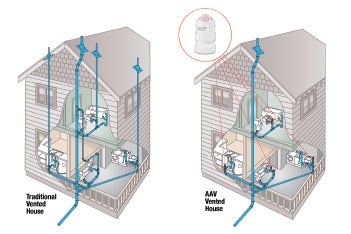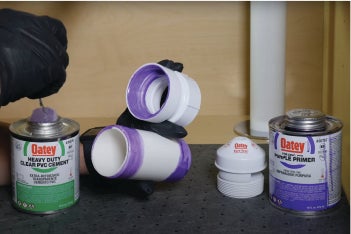The old adage, less is more, applies to much more than life lessons. For example, in home construction and renovation, it’s crucial to eliminate unnecessary costs while keeping both efficiency and aesthetics at the forefront. Air admittance valves do just that in terms of drain-waste-vent (DWV) systems.
The DWV system consists of drain and vent pipes that rid the home of waste. While the drain-waste pipes move the waste from various drains away from the house to a public sewer or septic tank, vent pipes perform double duty.
Not only do they ventilate sewage gasses out of the house through an exhaust-pipe roof penetration, but they also provide an air passageway behind water through the drain-waste system. This is where air admittance valves come into play.
What is an Air Admittance Valve?
Air Admittance Valves (AAV) — Oatey ®Sure-Vents® — are mechanical devices installed to a plumbing fixture, replacing a secondary vent. These valves allow one-way ventilation, removing the need to connect to an existing venting system or run a separate, potentially unsightly ventilation system.
In addition, AAVs eliminate the need for secondary roof penetrations. This key benefit not only impacts the design of the home in a positive way, but fewer roof penetrations also mean fewer chances of potential leaks in the future.
AAVs are ideal for applications such as kitchen-island sinks, remote bathrooms, and remodeling jobs. They offer cost and time savings to the homeowner and labor and material savings to the installing contractor.

How does an AAV work?
AAV plumbing operates on negative pressure activation. As water drains, air is pulled with the water as it drains, creating negative pressure. This opens the valve and allows air to be drawn into the system.
With Oatey’s Sure-Vent® AAV, a pressure change of -0.01psi (-0.25 inch H2O) activates the AAV to open. When that pressure is equalized, the AAV returns to its original seal, preventing sewer gasses from entering the vent.

Air Admittance Valve installation tips
» Choose the correct AAV: Check the Drain Fixture Unit (DFU) load before installation to make sure you choose the correct AAV. This value is determined by the total amount of water that comes through a fixture.
After calculating the DFU, select the appropriate AAV to handle the volume rate of discharge that comes through the fixture — taking into consideration if you are venting more than one fixture. Under-sizing your AAV can cause system malfunction.
| Fixture Applications | DFU Load |
|---|---|
| Traditional Public Bathroom Group (Toilet (1.6 gpf), bathtub w/ shower, and sink) | 6 |
| Traditional Private Bathroom Group (Toilet (1.6 gpf), bathtub w/ shower, and sink) | 5 |
| Public Toilet (1.6 gpf) | 4 |
| Private Toilet (1.6 gpf) | 3 |
| Washing Machine | 3 |
| Bathtub w/ Shower | 2 |
| Sink & Disposal | 2 |
| Dishwasher | 2 |
| Shower Stall (5.7 gpm or less) | 2 |
| Sink | 2 |
| Drinking Fountain | 0.5 |
» AAV plumbing valve placement: AAV plumbing valve placement must be installed vertically with no more than a 15° angle, remaining as level as possible. In addition, make sure the AAV is not permanently covered and is installed where air can freely enter the valve. The AAV should be located a minimum of four inches above the horizontal branch wall tube.
» Securing AAV: Measure and cut the PVC pipe appropriately. Solvent-weld the pipe into the adaptor using PVC cement, such as the Oatey® Heavy Duty Clear PVC Cement, which can be used for all PVC pipe and fittings. Also available is the Oatey® Purple Primer, which removes contaminants and softens the pipe surface for a secure weld.
Next, wrap thread tape onto the male threads of the AAV fitting and install the adaptor securely. Make sure to fill the sink with water to check for leaks.
See our step-by-step installation tutorial here.

Additional tips
AAV plumbing does not replace building requirements calling for a minimum of one stack vent directly penetrating the roof. In addition, it’s best to always check with your local municipality to approve the application.
For more install information, check out our blog: How to Install an Air Admittance Valve.